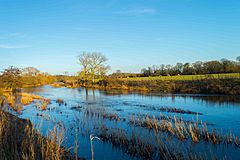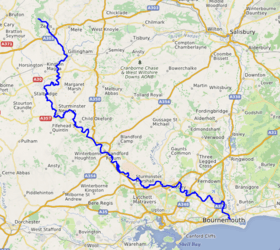River Stour, Dorset facts for kids
Quick facts for kids River Stour |
|
|---|---|

The Dorset Stour at Little Canford, just west of Canford Magna
|
|
 |
|
| Country | England |
| County | Dorset, Wiltshire, Somerset |
| District | Salisbury, South Somerset, North Dorset, East Dorset, Poole, Bournemouth, Christchurch |
| Towns | Gillingham, Sturminster Newton, Blandford Forum, Wimborne Minster, Christchurch |
| Physical characteristics | |
| Main source | Stourhead St Peter's Pump, Mere, Wiltshire |
| River mouth | Christchurch Harbour, Christchurch, Dorset 50°43′41″N 1°46′23″W / 50.72796°N 1.77295°W |
| Length | 61 mi (98 km) |
| Basin features | |
| Tributaries |
|
The River Stour is a 61-mile (97 km) long river in southern England. It flows through Wiltshire and Dorset. The river eventually empties into the English Channel. The area of land that drains into the Stour and its smaller rivers is about 1,240 square kilometers.
Contents
What's in a Name?
People sometimes call it the Dorset Stour. This helps tell it apart from other rivers named Stour in places like Kent and Suffolk. The name "Stour" sounds like "hour." It comes from an old English word meaning "violent" or "fierce."
The River's Journey
The River Stour starts from natural springs at Stourhead in Wiltshire. Here, it forms several artificial lakes. These lakes are part of the beautiful Stourhead estate, which is cared for by the National Trust.
The river then flows south into Dorset. It passes through the Blackmore Vale area. It also goes through the towns of Gillingham and Sturminster Newton.
- At Marnhull, the River Cale joins the Stour.
- Two miles later, the River Lydden also flows into it.
- Near Blandford Forum, the river cuts through the chalk hills of the Dorset Downs.
- From there, it flows southeast into the heathlands of southeast Dorset.
- At Wimborne Minster, the River Allen joins the Stour.
- Finally, at its estuary in Christchurch, the River Avon meets the Stour.
- The combined rivers then flow through Christchurch Harbour and into the English Channel.
From where it starts to where it meets the sea, the river drops about 230 meters. This happens over its 97-kilometer length.
A long time ago, a railway line followed the river for many miles. This was the old Somerset and Dorset Joint Railway. It crossed the river four times in just a 9-mile section. This was between Sturminster Newton and Blandford Forum.
The river flows mostly over clay soil. This means its water level changes a lot. In summer, the water is low. This creates an important habitat for many rare plants. In winter, the river often floods. Because of this, the land next to it is wide and fertile. This flat land is called a flood plain.
Many towns and villages in Dorset are named after the river. These include East Stour, West Stour, Stourpaine, and Sturminster Newton. Sturminster Newton has a famous water mill and an old town bridge. The bridge still has a sign warning people not to damage it.
River Life: Plants and Animals
The River Stour flows through many different natural areas. These include reed beds, open water, and coastal areas. Because of this, it is home to many interesting creatures.
Some animals you might find include:
- Pipistrelle bats
- Harbour porpoises
- Great crested newts
- Medicinal leeches
- Tiny Desmoulin's whorl snails
- And even the starlet sea anemone near the coast.
Many kinds of fish live in the river, such as:
- Barbel
- Bream
- Chub
- Dace
- Grayling
- Perch
- Pike
- Roach
- Rudd
- Salmon
- Tench
- Trout
The harbour at Christchurch has also been used for fishing. People have caught oysters, crab, lobster, and cuttlefish there. Bass and mullet fish use the estuary to feed and as a safe place for their young.
Downstream from Blandford Forum, there's an insect called the Blandford Fly. Its scientific name is (simulium posticatum). These flies are known for their painful bites on humans. People have tried to get rid of them using special sprays where the fly larvae live.
Fun on the River
The harbour at Christchurch and the lower parts of the Stour are great for boats. There are many marinas and boat clubs. You can sail or motorboat quite far upstream on the River Stour. The river is navigable up to Tuckton. There's a low bridge at Iford, but you can still go further. You can even go as far as some rapids about 1.5 km upstream from Iford Bridge.
Sometimes, very high tides can push water even further upstream. This can reach Blackwater Bridge (on the A338 road). You can rent boats from several places in the harbour and estuary area. Kayaking and canoeing are also very popular activities on the river.
The Stour Valley Way is a special long-distance footpath. It follows almost the entire length of the river. It's a great way to explore the area on foot.
The River in Books
The River Stour has appeared in some famous writings.
- Thomas Hardy wrote about it in his work, "Overlooking the River Stour."
- William Barnes also mentioned the river in his poem, "The Water Crowvoot."
- The Stour even shows up sometimes in "The Faerie Queene," a long poem by Edmund Spenser.
See also
 In Spanish: Río Stour (Dorset) para niños
In Spanish: Río Stour (Dorset) para niños

